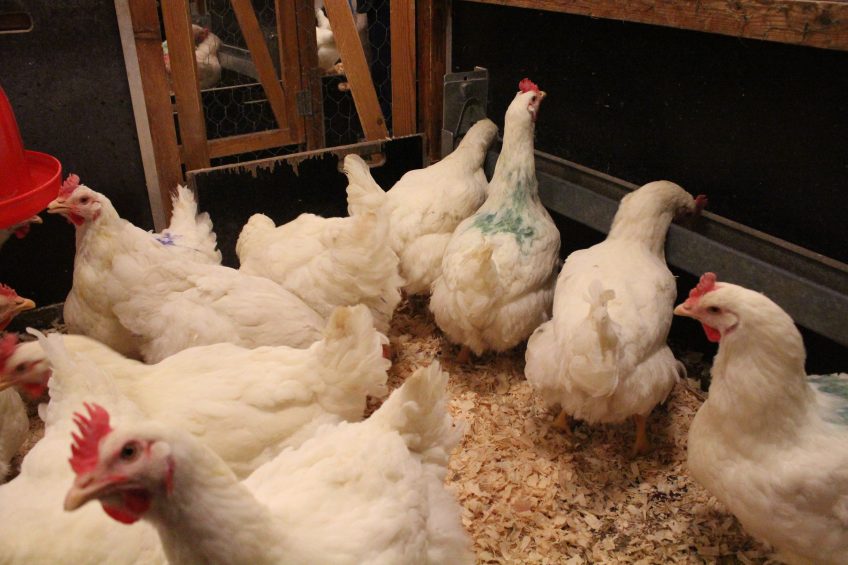Epigenetics for more efficient broilers

When broiler breeders are confronted with a lifetime of protein restriction, their offspring grow at least equally as fast as the broilers whose mothers and/or grandmothers never faced a protein restriction.
Over the past few decades there has been a lot of research on the performance of broiler breeders. According to Prof Johan Buyse, head of the laboratory of Livestock Physiology at Catholic University of Leuven in Belgium, the prevention of obesity and associated metabolic diseases, mortality and morbidity in broiler breeders is tricky because you have to carefully control the feed intake of the animals. “If you feed restrict them, their body weight is reduced and the egg production is again acceptable, but the animal might experience continuous feelings of hunger. This is a part of the broiler breeder paradox. You solve the problem of obesity, but it also creates a another welfare problem (hunger feeling) at the same time.”
Because topics such as the environment (for example, nitrogen emissions), sustainability (reducing global warming and CO2 production) and animal welfare for the European Union and some other countries in the world have become more and more important, Buyse decided to start a project with broiler breeders to at least partly counteract these problems. The project was named ‘Transgenerational effects of a reduced balanced protein diet on performance, welfare and behavior of broiler breeders and their offspring’. Remarkably, the research group of the Belgian professor didn’t receive any Flemish or European subsidies. “We have financed this project completely on our own.”
The starting point of this transgenerational broiler breeder project in September 2013 was to counteract all three issues, so environmental, animal welfare and sustainability, at one time. Buyse adds: “Or at least to solve partially. The research hypothesis was that by feeding a reduced balanced protein feed to broiler breeders you could improve breeder and offspring performance in a transgenerational way.” In September 2013 the research group welcomed the first day-old Ross 308 broiler breeder hens. The hens were housed at the zootechnical centre in the Belgian town Lovenjoel. The chicks were allocated to 10 floor pens with sixteen breeders per pen.
Improving gut fill
So, in total, 160 broiler breeders were set up, 80 animals allocated to the control group (C-group) and 80 animals were reared on a reduced protein diet. This group was determined the Reduced Protein-group (RP-group) throughout the transgenerational experiment. The two groups were held in the same housing facility under exactly the same circumstances. The animals of the RP-group received 25% less crude protein in their ration than the C-group, but balanced in terms of amino acids. Buyse says, “So also 25% less amino acids. They received up to 10% more feed in order to follow the same body weight curve as the control group. Otherwise, you are comparing apples to oranges.” One of the hypotheses of this project was; because the animals eat longer, the hunger feeling will be less explicitly present (which of course is better in terms of animal welfare) because of gut fill (satiety). Buyse: “If we look at the differences in behaviour between the C- and the RP-group after the daily meal we see that more animals of the RP-group rest and sit on the ground. According to us this is due to a longer-lasting gut fill, and it’s important for the well-being of the animal.”
The Belgian professor also noted that the broiler breeders of the RP-group were drinking less than those of the C-group. “The exact cause why these animals drink less we don’t know yet, but in a follow-up study this will surely be covered. We are already planning this future research and are still looking for financiers.” Another positive welfare effect because the animals are drinking less is that the bedding material quality of the RP-group remained much better. As a result, they had less foot pad lesions and the animals showed more dust bathing behaviour. Buyse notes, “And that had a positive effect, because thereby you have less frustrated behaviour, etc.”

Design of the research
The first generation of animals of the C- and RP-group was called the F0 generation. Buyse says,“What is special is that in this project the reduced protein diet was given during both the rearing period and the breeding period.” Artificial insemination was applied for each generation. “To avoid rooster effects, we used a mixed cocktail of sperm for both the C- and the RP-group,” Buyse states. The hatching eggs were collected during the laying peak of the F0 generation and set in at the laboratory incubators. A part of the juvenile female chicks (hence F1 generation) of the RP-group subsequently were fed the control feed and another part were fed again with the reduced protein diet. A part of the female juvenile chicks of the C-group received C-feed whereas another part received RP-feed.
So, in the 2nd phase (F1 generation) there were four test groups. Buyse adds, “After that, adult F1 breeders were inseminated, fertile eggs incubated and female chicks collected, resulting in four different groups of the F2 generation. As far as we know, a similar research project has never been done before in broiler breeders.” These four pilot groups of the F2 generation all received the C-feed. “In the F2 generation the reason for using the control feed again is that it’s not necessary to use RP-feed again in order to discern possible transgenerational effects.” By the F3 generation the research group had subsequently four groups of broiler chickens (eight groups after sexing the chicks).
No lower slaughter weight
In addition to the transgenerational research during this project, for every generation and for each group of broiler breeders, a part of the sexed offspring was raised common to broilers and were then slaughtered between 35 to 42 days. These broilers were given a standard iso-caloric broiler feed with 3000 – 3200 kcal/kg, but with a normal or reduced protein level. Buyse says, “For the broiler breeders we noticed in the F0 generation that the breeder hens that had received RP-feed did less well in terms of performance. For the broiler breeders of the F0 generation it meant an on average 12% lower laying percentage than the C-group.”
The peak laying rate of the C-group was about 77% and 66% for the RP-group, respectively. Buyse: “Also the eggs of the F0 generation of the RP-group were smaller and the egg weight was on average 7.5% lower. Also the egg albumen content was about 1.5 % lower. As a result, the day-old chicks were also smaller.” In itself for the transgenerational research of the professor this was no problem. However, for slaughter weights, this would be a problem. “But to our surprise, these smaller chicks gave after 35 days no lower slaughter weights at the slaughter line,” states Buyse, “meaning that when broiler breeders (mothers and/or grandmothers) are confronted with a protein restriction, the broilers of these hens grow at least as well as and have a better dietary protein utilisation compared to the offspring whose (grand)mothers have never faced a protein restriction.”

Three doctorates
These observations will have worldwide far-reaching consequences for the future according to the Belgian professor. Mainly because the nitrogen and protein utilisation of the offspring of these broiler breeders is better. “This also means that by transgenerational means, you can have more protein efficient animals which have a better feed conversion. If you look to the difference between male and female broilers, you can roughly say that male broilers fed on a low protein diet, in terms of growth, performed better than those fed a commercial control diet. The female broilers on the low protein diet had similar growth, but a significant better feed conversion,” Buyse says. More results of this project will be available after more research. This concerns data with regard to the meat and fat percentage, endocrinology, energy metabolism and gene expression.
The project ‘Transgenerational effects of a reduced balanced protein diet on performance, welfare and behavior of broiler breeders and their offspring’ is built in such a way that on the basis of this project three PhD students will complete their research. Meanwhile, Dr Congcong Li has obtained her doctorate a few weeks ago (digital version available on request). Buyse: “She has focused on the well-being and behaviour of the animals. PhD Jens Lesuisse will achieve his doctorate this summer and he has focused during this project on the performance of the F0 and F1 broiler breeders and their progeny.” PhD Seline Schallier will finalise her doctorate by end December 2018. She has mainly taken care of the performance of the F2 broiler breeders and their progeny. Schallier and Lesuisse are also dealing with the hatching results and molecular data. Indeed, during the project a genome-wide RNA-sequence (differential gene expression) was done. The data are currently being analysed by the research team.













